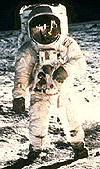
|
RACING TO THE
MOON
| "I believe that
this nation should commit itself to achieving the goal, before this
decade is out, of landing a man on the Moon and returning him safely
to the Earth. No single space project...will be more exciting, or
more impressive to mankind, or more important...and none will be so
difficult or expensive to accomplish...."
President John F. Kennedy, 1961
|
| "That's one
small step for man, one giant leap for mankind."
U.S. astronaut Neil Armstrong, on the Moon, 1969
|
 |
47 k jpeg
NASA#: 69-HC-684
Neil
Armstrong took this picture of
Buzz Aldrin on the Moon
during Apollo 11 mission. |
|
|
At
the start, there were no set rules for the Space Race. What was
the goal? What would count as winning?
For
Americans, President Kennedy's declaration focused the Space Race
on a clear goal: landing a man on the Moon before the Soviets. The
Space Race became a race to the Moon.
For
years, the Soviets officially denied being in a race to the Moon.
Now there is ample evidence, including items displayed here, that
they indeed competed to reach the Moon first.
|

SI#: 97-17207 |
PUBLICITY
VERSUS SECRECY
The
Space Race became a symbol of the broad ideological and political
contest between two rival world powers. The way the two competitors
organized to achieve their goals in space highlighted their basic
differences.
The
United States had separate civilian and military agencies, and only
the military space programs were secret. Civilian space activities--especially
the race to the Moon--were openly publicized for the world to see.
In
the Soviet Union, all space programs were integrated into a secretive
military-industrial bureaucracy. Launches were not announced in
advance, and only the successes were publicized.
|
|